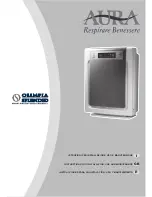
6 Configuration
Installation and operation manual
15
5TMV1B
VRV IV-S system air conditioner
4P399985-1B – 2015.06
N
L
a
X1M
X2M
b
a
a
Cable tie
b
Attachment plate
X1M
Power supply
X2M
Transmission wiring
5
Route the wiring through the frame and connect it to it.
Routing through
the frame
a
b
a
Power supply cable
b
Transmission wiring cable
Connecting to the
frame
When cables are routed from the unit, a
protection sleeve for the conduits (PG
insertions) can be inserted at the knockout
hole.
When you do not use a wire conduit,
protect the wires with vinyl tubes to
prevent the edge of the knockout hole from
cutting the wires.
a b c
d
e
A B
A
Inside of the outdoor unit
B
Outside of the outdoor unit
a
Wire
b
Bush
c
Nut
d
Frame
e
Hose
6
Reattach the service cover.
7
Connect an earth leakage circuit breaker and fuse to the power
supply line.
5.8
Finishing the outdoor unit
installation
5.8.1
To finish the transmission wiring
After installing the transmission wires inside the unit, wrap them
along with the on-site refrigerant pipes using finishing tape, as
shown in figure below.
a
b
c
d
e
a
Liquid pipe
b
Gas pipe
c
Insulator
d
Transmission wiring (F1/F2)
e
Finishing tape
6
Configuration
INFORMATION
It is important that all information in this chapter is read
sequentially by the installer and that the system is
configured as applicable.
DANGER: RISK OF ELECTROCUTION
6.1
Making field settings
6.1.1
About making field settings
To configure the heat pump system, you must give input to the
outdoor unit's main PCB (A1P). This involves the following field
setting components:
▪ Push buttons to give input to the PCB
▪ A display to read feedback from the PCB
Field settings are defined by their mode, setting and value. Example:
[2‑8]=4.
PC configurator
For VRV IV-S heat pump system it is alternatively possible to make
several commissioning field settings through a personal computer
interface (for this, option EKPCCAB is required). The installer can
prepare the configuration (off-site) on PC and afterwards upload the
configuration to the system.
See also:
"6.1.9 To connect the PC configurator to the outdoor
unit" on page 20
.
Mode 1 and 2
Mode
Description
Mode 1
(monitoring
settings)
Mode 1 can be used to monitor the current
situation of the outdoor unit. Some field setting
contents can be monitored as well.
Mode 2
(field settings)
Mode 2 is used to change the field settings of
the system. Consulting the current field setting
value and changing the current field setting
value is possible.
In general, normal operation can be resumed
without special intervention after changing field
settings.
Some field settings are used for special
operation (e.g., 1 time operation, recovery/
vacuuming setting, manual adding refrigerant
setting, etc.). In such a case, it is required to
abort the special operation before normal
operation can restart. It will be indicated in
below explanations.















































